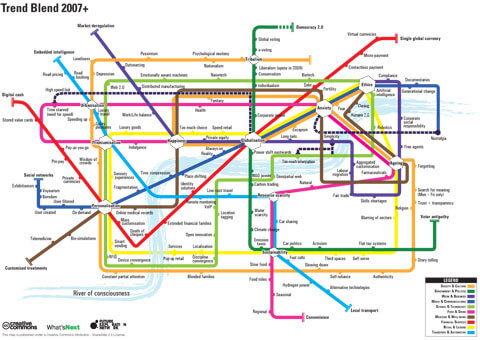At the end of every year media call on futurists to ask them what to expect in coming years, reflecting the appetite from their audiences for future thinking. One of the best ways to feed this desire is with infographics, distilling ideas into an accessible visual representation.
For the last four years a Trend Blend has been produced to close out the year. Each year this has been driven by Richard Watson of NowandNext, with myself and Future Exploration Network participating in the creation of the first three of these.
Below is a compilation of the four Trend Blends. You will see some themes recurring, and other fresh trends emerging over the years. All are intended to be fun and provocative, used both for general entertainment and sometimes for stimulating new thinking in the course of more serious futures and strategy work.
Click on the maps to see the detailed versions.

Trend Blend 2007+ map
Read more →

Facebook’s Nipplegate hits the front page
By Ross DawsonHey, I was there first! :-) On Saturday I wrote Breaking: Facebook bans doll nipples on profile images, about how my wife Victoria Buckley was told by Facebook she couldn’t show nude dolls on her Victoria Buckley Jewellery Facebook page.
Today the Sydney Morning Herald has featured this as its top story, with a headline Facebook nipplegate row and story by Asher Moses titled Now Facebook bans doll nipples. It says:
Read more →
Breaking: Facebook bans doll nipples on profile images
By Ross DawsonMy wife Victoria Buckley just received a message from Facebook asking her to change the profile image on the Victoria Buckley Jewellery Facebook page, threatening to close the page as it did not conform to its ‘terms and conditions’.
Presumably the were referring to condition3. 7. You will not post content that…contains nudity…. referring to the profile image of a beautiful doll touching one of Victoria’s rings.
Above is the offensive image. If you go to the Victoria Buckley Jewellery Facebook page you will now see a censored image so she doesn’t get banned, along with her close to 1,000 fans. (Though if you click through to the Photos page and the Ophelia Enchanted Doll collection you can see more stunning images of the doll).
Read more →
Asia is now the #1 and fastest growing region for Twitter; US down to just 25% of total tweets
By Ross DawsonMicro-messaging processing company Semiocast has just released research showing that Asia has overtaken North America as the biggest user of Twitter, with 37% of total tweets.
Source: Semiocast
In June 2009 the US still accounted for 55% of tweets, in February 2010 statistics showed that half of tweets were in languages other than English, and by April 2010 US tweets accounted for 37% of tweets. The rise of “international” (as Americans describe the planet excluding USA) and corresponding decline of the US share is shown in the chart below. Today’s study shows that US tweets have in the three months since then fallen to just 25% of the total. This is not because the US is slowing, it is because the rest of the world and particularly Asia is taking up Twitter at an enormous pace.
Read more →
Six platforms to get results from crowdsourcing
By Ross DawsonMyCustomer.com has just published a nice article based on an interview with me, titled Ross Dawson: Six tools to kickstart your crowdsourcing strategy.
After beginning with some background on the topicality of crowdsourcing, the article goes on:
Read more →
Trend Blend: 4 Infographics showing the major global trends
By Ross DawsonAt the end of every year media call on futurists to ask them what to expect in coming years, reflecting the appetite from their audiences for future thinking. One of the best ways to feed this desire is with infographics, distilling ideas into an accessible visual representation.
For the last four years a Trend Blend has been produced to close out the year. Each year this has been driven by Richard Watson of NowandNext, with myself and Future Exploration Network participating in the creation of the first three of these.
Below is a compilation of the four Trend Blends. You will see some themes recurring, and other fresh trends emerging over the years. All are intended to be fun and provocative, used both for general entertainment and sometimes for stimulating new thinking in the course of more serious futures and strategy work.
Click on the maps to see the detailed versions.
Trend Blend 2007+ map
Read more →
The sexual life of ideas: flirtation, promiscuity, procreation, and seminal creativity but no virgin births
By Ross DawsonHere’s a brief excerpt from Chapter 1 of Living Networks on the sexual life of ideas – I’ve always had a good response to this and it remains a relevant metaphor :-)
Ideas don’t like being alone. In fact they like copulating promiscuously with any other idea in sight. There is no such thing as a virgin birth in the world of ideas. Ideas are always born from other ideas: interacting, mating, and procreating. This often orgiastic coupling takes place in the fertile substrate which is the human mind. Our minds are hotbeds of unspeakable activities—ideas have a life of their own, but they need somewhere to carry on their flirtations and breeding.
In her book The Meme Machine, Susan Blackmore suggested that humans are purely and simply carriers for memes, which means ideas or behaviors that can be passed on to others. Our species has evolved to become a more refined vehicle for propagating ideas. One result is the desire to produce and consume mass media that seems so intrinsic to our race. Another is our drive to implement communication technologies, to engage more richly with others, and to publish on the Internet.
Read more →
The Social Internet: findings on how countries and regions engage differently with the web
By Ross DawsonOne of the topics that interests me the most is the variety with how different countries and cultures engage with social media, so I was very please to see in the current issue of Harvard Business Review a great spread on Mapping the Social Internet. Click on the image below to see the central visualization of how countries engage differently on the web.
Source: Harvard Business Review
The axes of the chart are the portion of internet users who manage a social-network profile, and the portion of internet users who write a blog, a choice of dimensions which yields a few very interesting perspectives:
Read more →
Inmagic interview on Enterprise 2.0 and chance to win an Implementing Enterprise 2.0 report
By Ross Dawson‘Social Knowledge Network’ vendor Inmagic recently spoke to me for their interview series. Unfortunately there were problems with the audio recording, so they’ve provided a transcript of the interview on issues including uptake of Enterprise 2.0, the Enterprise 2.0 vendor landscape, the future of work, and what I enjoy about my own work.
The full interview is worth a read, but here is a quick excerpt. I recently wrote what turned out to be a very popular post on What Enterprise 2.0 means for the CIO and IT department offering six key issues. Inmagic took a couple of these points and discussed them on their blog. Here is the follow-up on that during the interview.
Read more →
Population growth, urbanization, and the future of regional centers
By Ross DawsonOn the weekend Australia’s freshly minted Prime Minister Julia Gillard said “I don’t believe in a big Australia,” in an about face from her predecessor Kevin Rudd’s vision of strong population growth for the country.
As a futurist I have been increasingly drawn into this discussion, given that immigration is one of the most fundamental levers shaping the future of countries. I have discussed the coming rise of gerontocracy, the uncertainties in Australia’s demographic future, and was interviewed on the social impact of population growth in ABC TV’s special series on Australia’s future.
I was interviewed this morning about Gillard’s comment on ABC Ballarat, a town which is the hub of one of the largest regional centers in Australia. Non-urban regions have a particularly interesting perspective on population growth.
On the one hand, in the face of the inexorable global trend of urbanization, regional areas are consistently losing their youth and talent to the allure of cities. Concerted efforts are being made to revitalize the economies and culture of regions.
Read more →
A Declaration of Interdependence
By Ross DawsonA just got an email from Tiffany Schlain, who had just seen my post on how hyper-connectivity is literally bringing the networks to life. I know of Tiffany as the Founder of the very influential Webby Awards. What I didn’t know is that she is also a filmmaker. Tiffany pointed me to the film she’s currently working on: Connected: A Declaration of Interdependence. The awesome trailer is below – well worth watching. It simply poses the question we are all facing.
Read more →